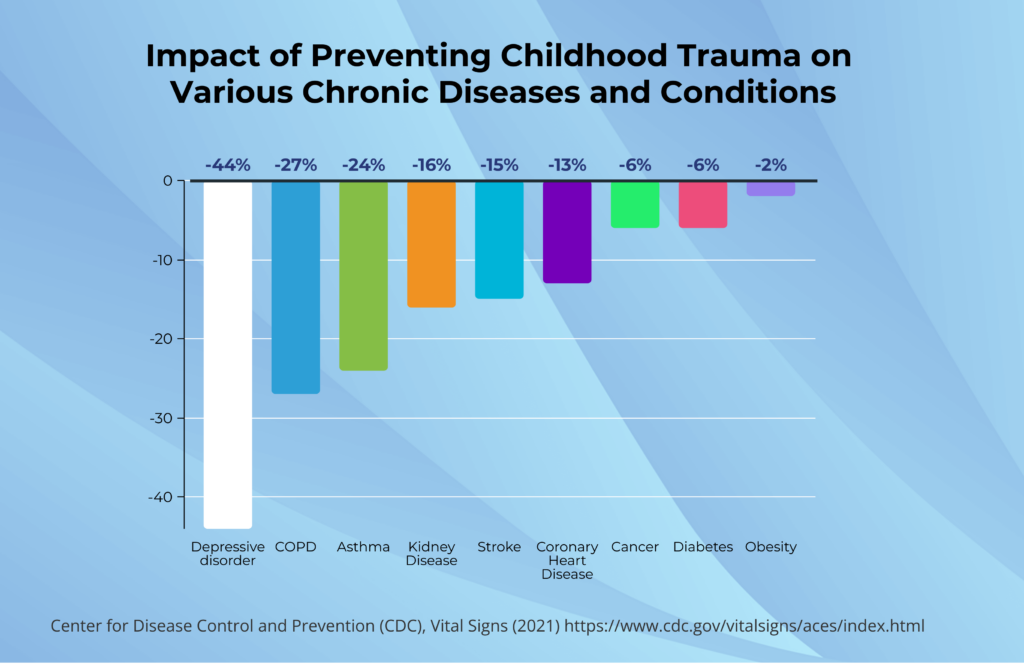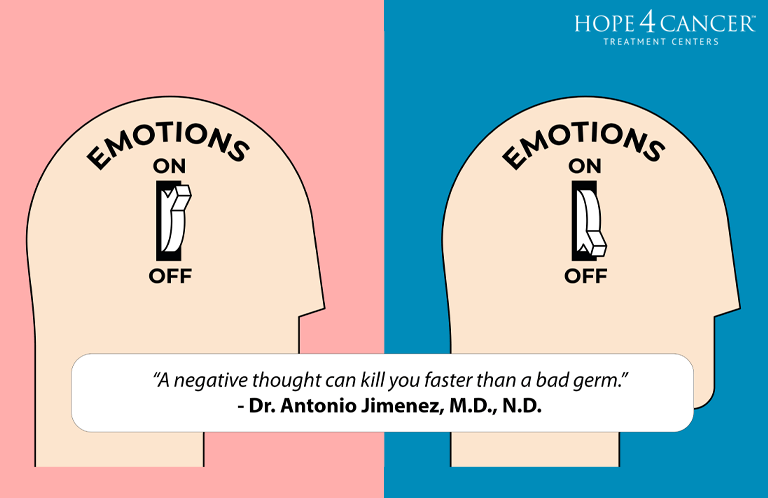Summary
- The body and the mind are connected, such that changes in one affect the other
- Emotional trauma can increase inflammation, depress the immune system, and contribute to the development of chronic diseases such as cancer.
- By detoxifying from emotional toxins, you turn off the fight-or-flight response, contributing to the health of your body and mind
Although we’ve been taught to think the body and mind aren’t connected, the fact is that your emotions can cause physical symptoms. The reason this seems so counterintuitive is that medicine has historically separated the two. The body and the mind were thought to be separate, disconnected entities, with physicians managing the physical body and psychologists independently managing the mind and emotions.
But with time, a select cross-section of medical doctors started to realize that many patients who suffered from chronic illnesses had also experienced some sort of psychological trauma. Dr. Hamer, a German physician, was one of those pioneers. Soon after his son was tragically killed in the late 1970s, Dr. Hamer developed testicular cancer. Always a healthy man, Dr. Hamer thought there had to be a link between the trauma of his son’s passing and his own development of cancer. Through his study of cancer patients, he realized that many had experienced a sudden, traumatic “conflict shock” before their cancer diagnosis.

Figure 1. According to 2017 estimates from the Centers for Disease Control and Prevention (CDC), prevention of adverse childhood experiences can reduce the incidence of many different types of chronic health conditions in adulthood.
In the mid-1990s, researchers at Kaiser Permanente made another connection between the body and the mind. This time, they studied childhood trauma and the development of disease as an adult. The results were overwhelming—the more abuse, neglect, violence, or poverty the child experienced, the higher their risk of developing diseases like heart disease, diabetes, and cancer as an adult (1). Interestingly, this association did not appear to be due to things like access to medical care or healthy food; it was due to the chronic activation of the fight-or-flight response. Based on national estimates from a 2017 report from the CDC’s Behavioral Risk Factor Surveillance System (BRFSS), preventing adverse childhood experiences that can lead to severe emotional traumas reduces the risk of several chronic diseases, including cancer (Figure 1) (2).
While the link between the body and mind sounds surprising at first, we already experience this link in our everyday lives! Remember the last time your stomach was in knots before a job interview or you felt your heart racing when you narrowly avoided a car accident? Both of these situations represent a triggering of the fight-or-flight response, also known as the sympathetic nervous system.

Figure 2. Our fight-or-flight mechanism was not designed for sustained activation of the sympathetic nervous system. The constant release of stress hormones leads to a variety of chronic diseases and conditions.
The fight-or-flight response isn’t always a bad thing—when our ancestors were trying to fight off a bear, for example, this bodily response was really helpful. But in today’s world, the things that activate our fight-or-flight response look less like bears, and more like stressful jobs or toxic relationships (Figure 2). When these everyday stressors become persistent or constant, your body releases a steady stream of stress hormones that wreak havoc over time by increasing inflammation and depressing the immune system, among other issues (Figure 3).

Figure 3. Stress causes the release of stress hormones (adrenaline, cortisol) that prompt various organs to respond in ways that protect and safeguard the body. However, when the switch for these responses is chronically switched on, this same response becomes the source of various chronic diseases and conditions.
Knowing the impact of your emotions on your physical body explains why it’s critically important to identify and eliminate sources of stress and trauma. Emotions like anger, resentment, and anxiety are like emotional toxins that must be detoxified before they can cause physical symptoms and disease. By recognizing past traumas and current stresses, we can achieve inner peace and ultimately heal.
But the road to peace looks different for everyone. Strategies that may work for you may not work for someone else, and while your friend may swear by one single strategy, you may utilize ten! Some people may also require professional help or guidance, like working with a Behavioral Emotional Spiritual Therapy (BEST) practitioner at Hope4Cancer. The BEST program creates an individualized, disease-focused, emotional-healing program and helps patients get to the root of their disease.
The strategies listed below are wonderful ways to begin your emotional healing journey and start detoxifying from emotional toxins! Alongside these strategies we recommend watching our “Emotions and Cancer” webinar featured on YouTube here.
1. Create a Timeline
Creating a timeline is a natural first step when looking to eliminate emotional toxins. The timeline takes a comprehensive look at your life and identifies the adverse experiences and emotional toxins to target. Some people can clearly point to the big conflicts in their life, while others may require some introspection and digging.
Start by writing out the major events in your life beginning with your birth. Look for difficult life experiences such as violence, neglect, or abuse, including physical, sexual, or emotional abuse. Write down notable events that you or someone in your family experienced, such as divorce, mental health issues, substance abuse issues, jail time, poverty, financial hardship, death, or loss. Events that carry extreme emotions like betrayal, resentment, anger, and sadness are good indicators of sources of toxins.
A timeline is like a blood test for toxins; by identifying the source of the conflict, you know where to start. Ask yourself questions such as, how did this hardship impact my life? Have I ever talked to anyone about it? Am I at peace with this event? If you’re not at peace, and if the event still elicits powerful emotions, it may be worth further investigation.
2. Spend Time with Friends and Family
Spending time with the important people in your life is an important way to detoxify your emotions. Instead of keeping your struggles to yourself, talking openly and honestly with trusted friends and family members can help you feel more supported. When you share your burdens with others, you may find that they offer valuable advice, a new perspective on the situation, or simply a compassionate listening ear. By relying on your support system, you can avoid turning to unhealthy coping mechanisms like drinking alcohol or suppressing your emotions.
A support system even appears to elicit positive effects on the body! Several studies have shown that having a friend by your side during a stressful moment can lessen blood pressure and heart rate (3). Perhaps due to the positive effects on the cardiovascular and immune systems, healthy relationships can also lengthen your life. In a meta-analysis of almost 150 studies, researchers found that having strong social relationships increased the likelihood of survival by 50%! (4)
Don’t have a strong social group? There’s no better time to put yourself out there. Seek support groups, community events, churches, and volunteer opportunities. By joining these types of organizations, you can not only meet new people and expand your social circle but also make a positive impact in your community. Engaging with others can also help you develop important social skills, provide a sense of purpose and fulfillment, and help you find new hobbies and interests.
3. Pray
Prayer is a personal practice that can help regulate your emotions in a number of ways. Whether you prefer to recite set prayers or speak to God directly, prayer can help reduce worry and fear, particularly in times of illness. By acknowledging a higher power and trusting in the idea that He is in control, prayer can provide a sense of comfort and reassurance that can help alleviate stress and anxiety. Moreover, prayer has been found to be a relaxation technique that can activate the parasympathetic nervous system, which is responsible for rest and relaxation. This can lead to a reduction in heart rate and blood pressure, as well as an overall sense of calm and well-being (5). By cultivating a sense of acceptance and releasing the need for control, prayer can help you let go of negative emotions and find peace in the present moment.
4. Meditate
Meditation has existed for thousands of years. In fact, the earliest written records of meditation trace back to 1,500 BC! Meditation can be done anytime, anywhere, and requires little to no instruction. All you have to do is sit in a quiet place, close your eyes, and focus exclusively on your breath. As you meditate, you’ll notice your thoughts straying—and that’s okay! As soon as you notice, simply bring your attention back to your breath.
As you make meditation a regular practice, you’ll notice an improvement in your ability to identify and dismiss anxious and pessimistic thoughts. Research shows that meditation can lead to physical changes in the brain, including increased activity in the prefrontal cortex, which is responsible for emotion regulation and decision-making, and decreased activity in the amygdala, which is responsible for anxiety, fear, and stress (6, 7) Meditation can also help to decrease the production of stress hormones like cortisol, leading to a sense of calm and well-being! (8)
5. Guided imagery
Guided imagery is a technique that involves imagining specific scenarios. Some scenarios are relaxing, like walking on a beach or lying in a peaceful meadow, while others involve reliving past experiences or having conversations with people who have hurt you. Although guided imagery typically involves a professional guide, it can also be performed independently with practice.
One of our favorite guided imagery techniques is the fireside chat. It’s a type of guided imagery that helps the participant forgive and let go of a traumatic event. It starts by imagining sitting around a fire with yourself at the present moment, yourself at the time of the trauma, the person who hurt you, and a mediator, friend, or God. The process looks different for everyone—some people have a conversation with the person who hurt them, trying to look at the situation from a different point of view, while others extend forgiveness to themselves or others. It can be a very freeing experience to have a conversation with someone in a way that may be impossible in real life. Very often our patients at Hope4Cancer experience a cathartic release that makes them break down in tears as they process the unlocked sentiments.
Many patients at Hope4Cancer also utilize a form of guided imagery that involves envisioning themselves as healthy, whole, and healed. Some envision healing light pouring through their body, while others envision their immune cells attacking cancer cells. These types of healing thoughts can elicit real, positive effects on the body and mind.
6. Set Healthy Boundaries
Setting healthy boundaries can improve your mental health by eliminating the source of emotional toxins. After all, you can’t detoxify from something you’re continually exposed to! Boundaries are clearly identified limits that you set for yourself and your relationships with others. They can be physical boundaries like personal space or emotional boundaries like behaviors you won’t tolerate from others. Boundaries can even be as simple as time limits, such as “I’m leaving no later than 9 pm.”
Boundary setting involves paying attention to how certain people and situations make you feel. Feeling drained, disrespected, uncomfortable, or pressured may be signs that a boundary should be set. While setting a boundary can be difficult and may involve having some tough conversations, it’s important to remember that boundaries are not about punishing or rejecting others, but about prioritizing your own well-being and communicating your needs effectively.
Although establishing boundaries can be challenging, maintaining them when they are overstepped can be even more difficult. It requires being firm and clear about where the boundary lies and consistent about maintaining it. It also may be necessary to remind others about your boundaries, just like reminding children not to touch a hot stove. By doing so, you reinforce the importance of your limits and ensure that they are respected.
7. Sleep
You know the phrase, “Don’t go to bed angry?” Well, some mental health experts disagree, arguing that people shouldn’t try to settle a conflict when they’re exhausted. Instead of hashing out an argument before bed, sometimes sleeping on a conflict can lead to a more smooth and peaceful resolution. In fact, according to several studies, being tired has been shown to intensify negative emotions and diminish positive emotions! (9) Sleep is a wonderful tool to reset your mind and take a fresh look at the situation in the morning. Often, stressful situations look much more manageable after a good night’s sleep.
In addition to the benefits of sleep, there are some practical steps you can take before bed to help calm your mind and detox from negative emotions. Journaling before bed can bring clarity and perspective, while deep breathing can physically relax you and make it easier to fall asleep. Having a relaxing bedtime routine can also help, including things like putting the phone away, reading a book, or taking a warm bath. Sleep is restorative and healing for both your body and mind!
References
1. Felitti, V.J., R.F. Anda, D. Nordenberg, et al., Relationship of childhood abuse and household dysfunction to many of the leading causes of death in adults. The Adverse Childhood Experiences (ACE) Study. Am J Prev Med, 1998. 14(4): p. 245-58.
2. Adverse Childhood Experiences (ACEs): Preventing early trauma to improve adult health. (2021). Centers for Disease Control and Prevention (CDC). https://www.cdc.gov/vitalsigns/aces/index.html
3. Kamarck, T.W., A.H. Peterman, and D.A. Raynor, The effects of the social environment on stress-related cardiovascular activation: current findings, prospects, and implications. Ann Behav Med, 1998. 20(4): p. 247-56.
4. Holt-Lunstad, J., T.B. Smith, and J.B. Layton, Social relationships and mortality risk: a meta-analytic review. PLoS Med, 2010. 7(7): p. e1000316.
5. Bernardi, L., P. Sleight, G. Bandinelli, et al., Effect of rosary prayer and yoga mantras on autonomic cardiovascular rhythms: comparative study. BMJ, 2001. 323(7327): p. 1446-9.
6. Boccia, M., L. Piccardi, and P. Guariglia, The Meditative Mind: A Comprehensive Meta-Analysis of MRI Studies. Biomed Res Int, 2015. 2015: p. 419808.
7. Kral, T.R.A., B.S. Schuyler, J.A. Mumford, et al., Impact of short- and long-term mindfulness meditation training on amygdala reactivity to emotional stimuli. Neuroimage, 2018. 181: p. 301-313.
8. Turakitwanakan, W., C. Mekseepralard, and P. Busarakumtragul, Effects of mindfulness meditation on serum cortisol of medical students. J Med Assoc Thai, 2013. 96 Suppl 1: p. S90-5.
9. Zohar, D., O. Tzischinsky, R. Epstein, et al., The effects of sleep loss on medical residents’ emotional reactions to work events: a cognitive-energy model. Sleep, 2005. 28(1): p. 47-54.




Thank all of you for this information. Please continue research and give healing to all those that need it.
May God bless you and give you discernment always.
We are so happy you enjoyed this blog post and we appreciate your support! Many blessings to you.